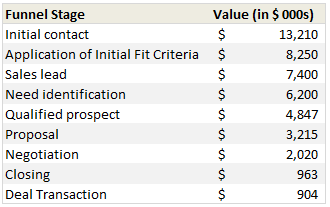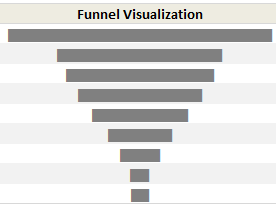Sales Funnel or Sales Process refers to a systematic approach to selling a product or service. [more on sales process]
Whether you run a small business or part of a large corporation, chances are, you heard about Sale Funnel. Understanding & analyzing your sales performance from a Funnel point of view is a great way to learn more about your sales processes.
About 2.5 years, we published an article on how to create Sales Funnel Charts using Excel. It shows, how you can tweak regular Excel bar chart to create a funnel chart.
Today, I want to show you a dead-simple way to create funnel charts using In-cell Charting Technique.
Take a look at the in-cell sales funnel chart:

Ready to make your own sales funnel chart? Well, lets get started then.
Step 1: Arrange your Sales Data
This is the easy part. Just arrange your sales process data in this fashion.

Step 2: Use an empty cell to define re-sizing factor
Since sales funnel numbers can be quite large, we need a way to reduce the numbers to meaningful size. I used 50 as my resizing factor (and entered this in cell C17). You can use 100 or 10 depending on your values.
Step 3: Generate In-cell Charts
In the column next to sales process numbers, we use REPT formula to generate In-cell charts. We will print | symbol ‘n’ number of times, where ‘n’ is sales process value / re-sizing factor.
For ex. this is the formula for first row:

Step 4: Change the font for In-cell Charts to “Playbill” size 11
The default Excel font (Calibri or Arial) produces an ugly looking in-cell chart. To fix this, we just need to change the font of in-cell chart cells to Playbill, size 11. (You can also use Script font, size 8 with Bold).
At this point, our funnel chart looks like a skewed funnel:

Step 5: Align Center to make the funnel chart
Now, just select all the in-cell chart cells & align to center. That is all. Our funnel chart is ready.

Download Sales Funnel Chart Template
Click here to download the sales funnel chart template & play with it. Go nuts analyzing your funnel or wowing at the simplicity of this technique.
How do you analyze your Sales Funnel?
Since I run a small business, understanding how my sales process works is important for me. However, since my sales process has only a few steps, I use ad-hoc funnel analysis. For example, I have these stages for my sales process:
- You visit Chandoo.org (casual visitor, possible thru search)
- You become a lover of Chandoo.org (loyal visitor, spends more than 15 mins per visit)
- You visit one of the product pages (designated sales pages)
- You click on purchase button (measured by the number of sales)
I do not track these at individual level, instead, I only measure the numbers at monthly aggregates and then do simple analysis like measuring conversion %s to see if everything is alright. Also, quite often, regular visitors of Chandoo.org convert to customers only after visiting us for a few months.
What about you? How do you analyze your sales funnel. What kind of charting techniques you use? Please share using comments.


















23 Responses to “Displaying Text Values in Pivot Tables without VBA”
Its possible to display up to 4 text values.
Have a look at the screen shot of an example that I had posted way back at the EHA and figure out how its done !
http://tinypic.com/r/muzywk/6
With Excel 2010 you can use Conditional Formatting to apply custom number formats which can display text. (In older versions you can only modify text color and cell background color, but not number formats.) Using CF allows for an even larger number of different display values.
[...] Display text values in Pivot Tables without VBA [...]
Hey,
Thanks, this helps. But how do you do it for multiple values where there is a huge amount of non repeating text?
@Soumya
The only way to do more than 4 values is to make the Pivot Table manually with formulas, of course then it isn't a Pivot table
You can of course do it with VBA
You may want to have a look at this description of how to do it here: http://www.clearlyandsimply.com/clearly_and_simply/2011/06/emulate-excel-pivot-tables-with-texts-in-the-value-area-using-vba.html
@Soumya
The only way to do more than 4 values is to make the Pivot Table manually with formulas, of course then it isn’t a Pivot table
You can of course do it with VBA
You may want to have a look at this description of how to do it here: http://www.clearlyandsimply.com/clearly_and_simply/2011/06/emulate-excel-pivot-tables-with-texts-in-the-value-area-using-vba.html
[...] Pivot Tables take tables of data and allow the user to summarise and consolidate the data at the same time. This is a great and very fast method of analysis but is restricted to handling mathematical functions on the value field resulting in numerical summaries. – read more [...]
[…] Read more here: Displaying Text Values in Pivot Tables without VBA […]
There is a very good way actually for handling text inside values area.
First you create a special column on the very left side and call it ID, and put unique ID (numbers only), and then create a pivot table with:
Row Labels and Column labels as you like, and in the Values labels use the unique ID number.
Move the unique ID number (copy paste) somewhere to the right and use vlookup to load the data you need using the ID as reference.
It is a bit longer way but for me it works perfectly to combine values as you like in any moment.
hope helps.
Regards,
Jon
Thank you! I finally understand pivot tables thanks to your clear, concise explanations and examples.
Good Day. This is exactly what i have been looking for. However when i try it on my pivot table or even when i try to recreate this exercise using the sample worksheet, i get this error:
"Microsoft Excel cannot use the number format you typed. Try using one of the built-in number formats."
Same thing here, Excel quite did not like the format in my PowerPivot. Any clues as to what may be going on? Thanks.
I have the same thing happening on my end. I'm running a normal pivot table on a .xlsm file.
@Danzi
What format did you use?
can you post the file ?
pls. help in table there is name, pan. amount. i have to make pivot table for example
NAME PAN AMOUNT
MR.X AAAAC1254T 500.00
MR.Y AAABR1258C
MR.A CFVDE2458T
MR.Z AAVCR12548C
MR.X AAAAC1254T
MR.Z AADCD245T
pls. help in table there is name, pan. amount. i have to make pivot table for example
NAME PAN AMOUNT
MR.X AAAAC1254T 500.00
MR.Y AAABR1258C 1000
MR.A CFVDE2458T 2000
MR.Z AAVCR12548C 5451
MR.X AAAAC1254T 45564
MR.Z AADCD245T 4500
how to get pivot tabe so i get PAN no. against Name.
I found an easy way to get text values in pivot table.
I create an other worksheet in wich each cell has a formula that copy the pivot table. The trick is that the formula does a lookup for the numbers in the pivot table.
The formula looks like that:
=IF(ISNUMBER(table!A1);VLOOKUP(table!A1;Code!$A$1:$B$65;2);IF(ISBLANK(table!A1);" ";table!A1))
Code is a worksheet where there is a liste of text /numbers correspondance.
As a bonus The new sheet is easier to format
Additional trick:
In my case, i encoded differents codeid with a power(2, codeId-1) so that summing then is equivalent to concatenate them.
1-A
2-B
4-C
8-D
yields :
5 - AC
14 - BCD
Hi
I want to ask if pivot can display dates in pivot field. As in a column i have customers and in row different items i want to know there last purchase date. anyone help in this??
Hello Guys, Need your help
I am doing some analysis of the cycle time of the product i.e how much time a product takes from manufacturing to the central warehouse.
I have batch numbers for the product and against them i have to pull out the diff. dates
Like the base date is from where the manufacturing start. So i have the batch number,against it's manuf. date. Now i have to pull out the date when it was quality released.
I have the quality released data but the data have duplicates, like i will have two dates or may be three for the same batch. So my main objective is to pull out the date which is latest among them.
BATCH NO. DATE of Mfg. DATE of Quality release
A1 12/4/2014 (HERE I HAVE TO PULL value)
Next Sheet
BATCH NO. DATE of Quality Release
A1 14/5/2014
a2 23/5/2016
A1 12/5/2014
A1 13/6/2014
From this sheet i have to pull up the latest date format of date here is dd/mm/yyy
TIA
[…] needed to present text instead of counts in a pivot table value column. Here is an excellent resource for Excel manipulation, in addition to an overview of pivot […]
This is great thank you.
Wow!!! Excellent!! It helped me a lot.
I am developing training tracking sheet for 200 employees with training completed date. Each employee will be attending 25 courses. How to indicate actual dates in pivot table value field.